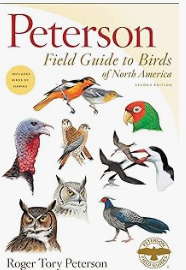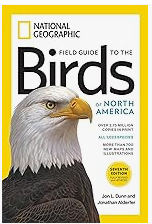Get Resources to Identify and Learn more about Birds
There are over 600 species of birds that regularly occur in North America! So how do you try to start trying to learn them all? You don’t. You use the process of elimination. You start by learning what birds are at your location, at a certain time of year, and in the habitat where you are. Usually, only a dozen or so birds are possibilities when all three of these criteria are required. You can go through this process of elimination by using an app or a book called a field guide.
In addition to identifying bird sounds, the Merlin app (by Cornell Lab of Ornithology) also helps you identify birds you see using a process of elimination. A second free app that is a great secondary resource to keep on your phone is the National Audubon Field Guide to Birds app. The Audubon app provides you with range maps that give information about where geographically birds are found and at what time of year they are found where. Written descriptions describe the habitat of each bird species. There are also recordings of what the bird sounds like and photographs showing differences in males, females, and immatures.
While phone apps are extremely convenient because you have them with you at all times, traditional field guide books provide something that apps don’t – an easy way to compare and contrast similar looking species. For example, it is far easier to understand the difference between multiple species of warblers that have patches of both black and yellow if you can see them all side by side.
Some field guide books use photographs while others use illustrations. No one field guide has it all. That’s why veteran birdwatchers typically own at least two or more bird field guides.
Here are some of the most commonly used bird guides:
Sibley Guide to Birds. 2nd edition
This is a larger book with larger illustrations of all the birds of North America. It has the most illustrations showing differences in plumages by sex and age. The introductory section is full of detailed descriptions that can be overwhelming to the novice.
The Sibley Guide to Birds of Eastern North America
This smaller book is easier to carry around, but has the same images as the larger book but just for the eastern species.
Peterson Field Guide to Eastern Birds
This book has stylistic illustrations emphasizing the identification features of each species (called “field marks”). The introduction section of this book is straightforward making it easier for a novice to understand. It is a good complement to the Sibley Guide to Birds for the beginner.
National Geographic Field Guide to the Birds of North America (Third edition)
This field guide has full-color illustrations for more than 800 North American birds. It has range maps and detailed descriptions.
The Stokes Field Guide to the Birds (2013)
This field guide uses photographs to illustrate what each species looks like. For those who enjoy having a book in your hand while reading and learn by perusing photographs, this would be a good addition to your library.
The Crossley ID Guide Eastern Birds
This is a great reference book for birders who are trying to learn all the birds in their area. Its large size makes it one of those books you keep at home as a resource.
 |  |  |  |  |  |